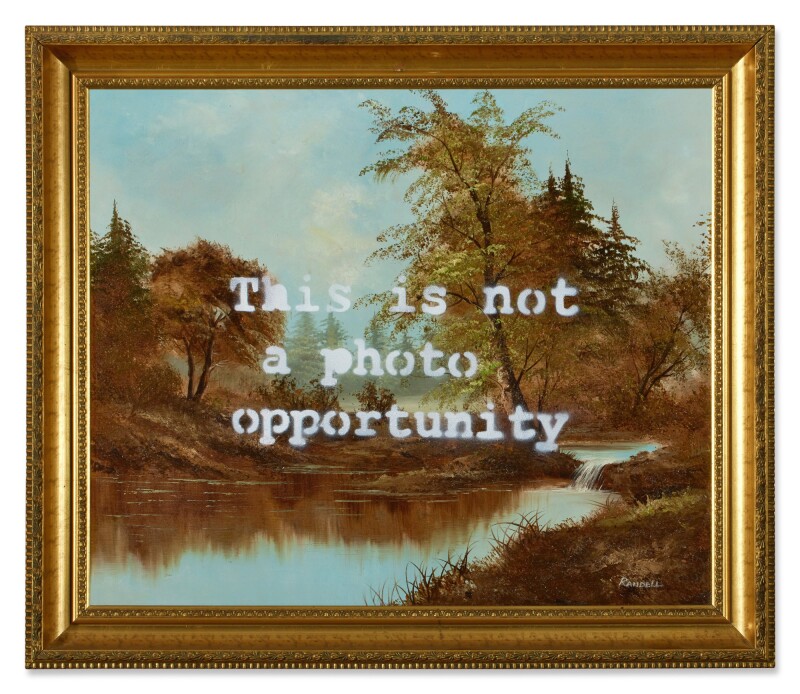Few artists have managed to blend art, activism, and anonymity as effectively as Banksy, the elusive British street artist whose work continues to spark global conversations. Known for his stencil-based graffiti and biting social commentary, Banksy’s “This Is Not a Photo Opportunity” is a powerful example of his ability to challenge contemporary issues through art.
This provocative piece, featuring a hooded figure holding a rifle, is accompanied by the stark phrase “This is not a photo opportunity”. As with much of Banksy’s work, this statement forces viewers to rethink their perceptions of media, conflict, and the spectacle of violence.
Decoding Banksy’s Message: What Does “This Is Not a Photo Opportunity” Mean?
Banksy’s art is often open to interpretation, but This Is Not a Photo Opportunity delivers an undeniably powerful message.
A Critique of Media Sensationalism
The media thrives on shocking imagery, often using conflict and suffering as compelling narratives for headlines.
The phrase “This is not a photo opportunity” calls out this tendency to capture rather than act—reminding us that these are real-life events, not just stories for consumption.
By depicting a hooded, armed figure, Banksy forces the audience to confront the harsh realities of violence—not as an aestheticized image, but as a representation of real-world suffering.
The Desensitization to Violence
In an age of instant news cycles and viral content, the world often witnesses graphic images of war, police brutality, and suffering without fully processing the gravity of these events.
The phrase highlights how violence has become normalized, with people passively consuming images of crisis rather than engaging in meaningful action.
Banksy’s stark, stencil-based aesthetic ensures that the message is direct and unfiltered, evoking a sense of urgency and discomfort.
The Power of Visual Activism
Street art, especially when executed in public spaces, has the ability to interrupt daily life and provoke spontaneous reflection.
Banksy’s use of highly visible, politically charged imagery ensures that his work is not just viewed but actively discussed, photographed, and shared globally.
Ironically, the piece itself has become a popular photo subject, further demonstrating Banksy’s point—how quickly we turn real struggles into Instagram-worthy moments.
Analyzing the Artistic Elements of Banksy’s Work
Banksy’s artistic choices in This Is Not a Photo Opportunity amplify its impact and accessibility.
Stencil Technique: A Signature of Banksy’s Style
Banksy’s stencil-based approach allows him to quickly execute pieces in urban spaces, often under the cover of night.
The precise, clean-cut edges of his stencils give his work a poster-like immediacy, ensuring that the message is clear and unambiguous.
This style mimics street signage, reinforcing the idea that these messages should be read urgently and seriously.
High Contrast & Silhouette Imagery
The dark figure against a lighter background creates a stark visual impact, immediately drawing the viewer’s eye.
By using a silhouette, Banksy removes specific identity markers, making the figure symbolic of broader issues like war, oppression, and systemic violence.
Strategic Placement in Public Spaces
Like most of Banksy’s works, This Is Not a Photo Opportunity was strategically placed in high-traffic urban areas, ensuring maximum visibility.
The placement itself reinforces the message—street corners, walls, and buildings where people pass by without noticing, much like how society often overlooks deeper social issues.
Banksy and the Politics of Public Art
Street art exists in a unique space between art, protest, and vandalism. Banksy’s work frequently tests the boundaries of what is considered acceptable or legal artistic expression.
The Role of Anonymity in Banksy’s Work
Banksy’s refusal to reveal his identity allows him to remain a neutral, yet powerful voice in political commentary.
His anonymity ensures that the focus remains on the message rather than the artist’s personal brand.
Street Art as a Tool for Protest
Unlike art confined to galleries, street art is accessible to everyone—regardless of socioeconomic status.
It bypasses traditional art institutions, making it a raw and immediate medium for activism.
Controversy & Government Crackdowns
Banksy’s work often critiques governments, corporations, and law enforcement, leading to efforts to paint over or remove his murals.
Ironically, attempts to censor his work often increase its visibility, turning it into a symbol of suppressed voices and resistance.
The Lasting Impact of This Is Not a Photo Opportunity
Banksy’s This Is Not a Photo Opportunity remains relevant years after its initial appearance, continuing to spark conversations about:
The role of media in shaping public perception of violence.
The moral responsibility of photographers, journalists, and consumers of news.
The power of street art as a form of political resistance and social critique.
As with many of Banksy’s works, this piece challenges the viewer to question their role in society—are we merely observers, or do we take action when confronted with injustice?
Final Thoughts: Why Banksy’s Message Still Matters
Banksy’s This Is Not a Photo Opportunity is more than just street art—it’s a powerful visual commentary on society’s relationship with violence, media, and activism.
It exposes the contradictions of modern media, where real suffering is often turned into consumable content.
It forces viewers to examine their own role in either perpetuating or challenging systems of violence and injustice.
It reaffirms the power of street art as one of the few uncensored, unfiltered mediums for political expression.
At a time when the world is inundated with images of war, inequality, and crisis, Banksy’s message remains more relevant than ever—reminding us that behind every viral photo is a real person, a real story, and a real struggle that deserves more than just a moment of attention.
No comments yet.








